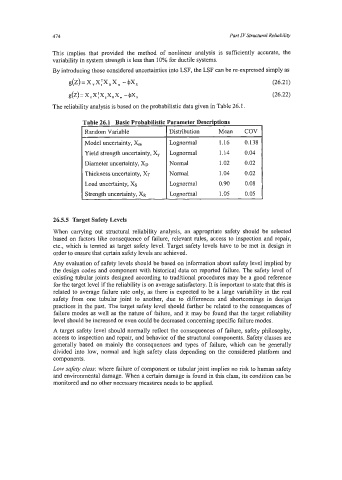Page 498 - Marine Structural Design
P. 498
474 Part IV Structural Reliability
This implies that provided the method of nonlinear analysis is sufficiently accurate, the
variability in system strength is less than 10% for ductile systems.
By introducing those considered uncertainties into LSF, the LSF can be re-expressed simply as
g(z)=x,x:x,x, -4% (26.21)
(26.22)
g(z)=x,x:x,x,x, -6s
The reliability analysis is based on the probabilistic data given in Table 26. I.
Table 26.1 Basic Probabilisti 'arameter Descriptions
Random Variable Distribution Mean COV
Model uncertainty, X, Lognormal 1.16 0.138
Yield strength uncertainty, X, Lognormal 1.14 0.04
Diameter uncertainty, XD Normal 1.02 0.02
Thickness uncertainty, XT Normal 1.04 0.02
Load uncertainty, & Lognormal 0.90 0.08
Strength uncertainty, XR Lognormal 1.05 0.05
26.5.5 Target Safety Levels
When carrying out structural reliability analysis, an appropriate safety should be selected
based on factors like consequence of failure, relevant rules, access to inspection and repair,
etc., which is termed as target safety level. Target safety levels have to be met in design in
order to ensure that certain safety levels are achieved.
Any evaluation of safety levels should be based on information about safety level implied by
the design codes and component with historical data on reported failure. The safety level of
existing tubular joints designed according to traditional procedures may be a good reference
for the target level if the reliability is on average satisfactory. It is important to state that this is
related to average failure rate only, as there is expected to be a large variability in the real
safety from one tubular joint to another, due to differences and shortcomings in design
practices in the past. The target safety level should hrther be related to the consequences of
failure modes as well as the nature of failure, and it may be found that the target reliability
level should be increased or even could be decreased concerning specific failure modes.
A target safety level should normally reflect the consequences of failure, safety phiIosophy,
access to inspection and repair, and behavior of the structural components. Safety classes are
generally based on mainly the consequences and types of failure, which can be generally
divided into low, normal and high safety class depending on the considered platform and
components.
Low safety class: where failure of component or tubular joint implies no risk to human safety
and environmental damage. When a certain damage is found in this class, its condition can be
monitored and no other necessary measures needs to be applied.

